Read-alouds are for everyone. Reading aloud a picture book, a short story, a poem, or a passage from a chapter book is an effective way for teachers, librarians, and parents to introduce young people to new topics. At all ages, read-alouds can be starting points for discussions, including difficult ones that require safe environments. The sense of community that comes with the experience of sharing a good story is more important than ever. Keeping in mind the joy that comes from the reading of a well-crafted story, this week’s column includes some stories that are fun to read aloud, and to listen to, because of their playful language and inspiring messages.
Ages 4–8
Antoinette. Kelly DiPucchio. Ill. Christian Robinson. 2017. Atheneum/Simon & Schuster.
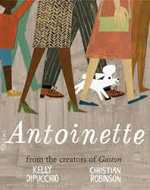
Antoinette, a poodle, has three bulldog brothers, each with a special talent: Rocky isclever, Ricky is fast, and Bruno is strong. Antoinette, however, still hasn’t discovered what makes her extra special. One day Ooh-La-La, the sister of her best friend, Gaston, goes missing while the two doggy families play in the park; Rocky, Ricky, and Bruno put their special talents to work but fail to find the missing poodle. Then Antoinette, who “felt a tug in her heart and a twitch in her nose,” sets out through the street of Paris, tracking Ooh-La-la to the Louvre. Evading the guard, who loudly proclaims, “No dog allowed,” Antoinette runs through the galleries and arrives just in time to save Ooh-La-La from a perilous fall. She’s discovered her special talent: bravery. Robinson’s flat, childlike, warmly colored acrylic paintings beautifully detail the Parisian setting. For a perfect read-aloud session, you’ll want to read DiPucchio and Robinson’s Gaston (2014), too.
Everybunny Dance! Ellie Sandall. 2017. Margaret K. McElderry/Simon & Schuster.
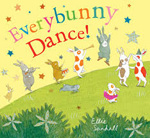 “EVERYBUNNY DANCE! / And clap your paws, / and twist and twirl, and shake your tail, / and wiggle and whirl.” And that’s just what a large bunch of colorful bunnies do across double-page spreads. They also play musical instruments and merrily sing “Fa-la-la-la, tra-la-la-lee, doo-dooby-doo, fiddle-de” until they notice a fox watching them. “EVERYBUNNY RUN!” Unaware of his hidden audience, the fox dances, plays a clarinet, takes a graceful bow, sighs, and tears up—until “EVERYBUNNY CLAP!” Then they all run and jump and dance and play, “all together, every day” as new friendships are made. Young children will enjoy counting bunnies and spotting the ones that wear bowties, tutus, and ballet shoes in the illustrations—and will be eager to get up and frolic along with everybunny and the fox.
“EVERYBUNNY DANCE! / And clap your paws, / and twist and twirl, and shake your tail, / and wiggle and whirl.” And that’s just what a large bunch of colorful bunnies do across double-page spreads. They also play musical instruments and merrily sing “Fa-la-la-la, tra-la-la-lee, doo-dooby-doo, fiddle-de” until they notice a fox watching them. “EVERYBUNNY RUN!” Unaware of his hidden audience, the fox dances, plays a clarinet, takes a graceful bow, sighs, and tears up—until “EVERYBUNNY CLAP!” Then they all run and jump and dance and play, “all together, every day” as new friendships are made. Young children will enjoy counting bunnies and spotting the ones that wear bowties, tutus, and ballet shoes in the illustrations—and will be eager to get up and frolic along with everybunny and the fox.
I Am (Not) Scared. Anna Kang. Ill. Christopher Weyant. 2017. Two Lions.
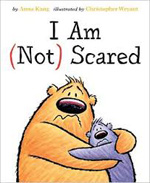 The big orange-brown bear and the small purple bear from You Are (Not) Small (2014) and That’s (Not) Mine (2015) are back for another discussion. Expressive watercolor-and-ink cartoon illustrations on expansive white backgrounds keep the focus on the two friends in their back-and-forth debate. “You are scared. / I am not scared. Are you? / No, I am brave. This will be fun! / You look scared.” There are visual clues as to what has them worried, and they are really scared as the rollercoaster approaches with a huge green snake in one of the cars. They bravely decide to be scared together, and by the end of the thrilling ride, they are ready for another one. This time the “WE ARE SCARED!!!” cries of the two bears and the snake are gleeful. This is a fun book with a gentle lesson on acknowledging fears and facing them with friends.
The big orange-brown bear and the small purple bear from You Are (Not) Small (2014) and That’s (Not) Mine (2015) are back for another discussion. Expressive watercolor-and-ink cartoon illustrations on expansive white backgrounds keep the focus on the two friends in their back-and-forth debate. “You are scared. / I am not scared. Are you? / No, I am brave. This will be fun! / You look scared.” There are visual clues as to what has them worried, and they are really scared as the rollercoaster approaches with a huge green snake in one of the cars. They bravely decide to be scared together, and by the end of the thrilling ride, they are ready for another one. This time the “WE ARE SCARED!!!” cries of the two bears and the snake are gleeful. This is a fun book with a gentle lesson on acknowledging fears and facing them with friends.
The Rooster Who Would Not Be Quiet! Carmen Agra Deedy. Ill. Eugene Yelchin. 2017. Scholastic.
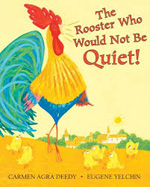 Everyone and everything in La Paz had a song to sing, making the village a happy but very noisy place, where it was hard to hear, sleep, and think. The solution: Elect a mayor who promises peace and quiet. Once in office, Don Pepe’s restrictive laws make La Paz as silent as a tomb—until the rooster who would not be quiet defies the laws. After repeated efforts to silence the rooster’s Kee-kee-ree-Kee! fail, Don Pepe threatens to make soup of him. Hearing the rooster’s declaration that he sings for those who dare not sing or have forgotten how to sing, the villagers take up his song and their chorus of Kee-kee-ree-Kee! drives Don Pepe out of town. Once again, the village is a very noisy and happy place. Yelchin’s sunny mixed-media illustrations are joyful and humorous. Deedy’s appended note provides a context for the allegorical tale: “There are always those who resist being silenced, who will crow out their truth, without regard to consequence. Foolhardy or wise, they are the ones who give us the courage to sing.”
Everyone and everything in La Paz had a song to sing, making the village a happy but very noisy place, where it was hard to hear, sleep, and think. The solution: Elect a mayor who promises peace and quiet. Once in office, Don Pepe’s restrictive laws make La Paz as silent as a tomb—until the rooster who would not be quiet defies the laws. After repeated efforts to silence the rooster’s Kee-kee-ree-Kee! fail, Don Pepe threatens to make soup of him. Hearing the rooster’s declaration that he sings for those who dare not sing or have forgotten how to sing, the villagers take up his song and their chorus of Kee-kee-ree-Kee! drives Don Pepe out of town. Once again, the village is a very noisy and happy place. Yelchin’s sunny mixed-media illustrations are joyful and humorous. Deedy’s appended note provides a context for the allegorical tale: “There are always those who resist being silenced, who will crow out their truth, without regard to consequence. Foolhardy or wise, they are the ones who give us the courage to sing.”
Ages 9–11
The Alphabet Thief. Bill Richardson. Ill. Roxanna Bikadoroff. 2017. Groundwood/House of Anansi.
 In the dark of night, the Alphabet Thief creeps through the city, creating havoc as she steals letters from words in alphabetical order. As a’s are stolen, coats became cots, fairs turned into firs, and boats became bots—and so on through the alphabet. The clever Alphabet Thief handles the q-with-u problem by removing them as a pair, so that queasy was easy and squash became sash. Having nearly reached the end of the alphabet, the Alphabet Thief seems unstoppable until the red-headed narrator, who has been following her, turns y’s into slingshots and fires z’s at the thief, forcing the thief to release the stolen letters: “When I open her sack, the letters spring back / And hurry on home to their words.” The clever and silly story in rhyme and playful ink-and-watercolor illustrations of word transformations may inspire readers to try some letter thievery of their own.
In the dark of night, the Alphabet Thief creeps through the city, creating havoc as she steals letters from words in alphabetical order. As a’s are stolen, coats became cots, fairs turned into firs, and boats became bots—and so on through the alphabet. The clever Alphabet Thief handles the q-with-u problem by removing them as a pair, so that queasy was easy and squash became sash. Having nearly reached the end of the alphabet, the Alphabet Thief seems unstoppable until the red-headed narrator, who has been following her, turns y’s into slingshots and fires z’s at the thief, forcing the thief to release the stolen letters: “When I open her sack, the letters spring back / And hurry on home to their words.” The clever and silly story in rhyme and playful ink-and-watercolor illustrations of word transformations may inspire readers to try some letter thievery of their own.
A Trio of Tolerable Tales. Margaret Atwood. Ill. Dušan Petričić. 2017. Groundwood/House of Anansi.
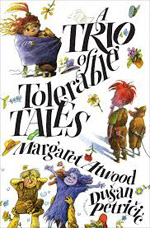 “Rude Ramsay and the Roaring Radishes,” “Bashful Bob and Doleful Dorinda,” and “Wandering Wendy and Widow Wallop’s Wunderground Washery” are a trio of tolerable—and tantalizing— tales about intriguing characters who find themselves in incredible situations. Margaret Atwood imaginatively tells these short stories with nonstop tongue-twisting alliterative wordplay. For example, Wenda, a waif who is taken by the Widow Wallop to work in her Wunderground Washery, is “a willowy child with wispy hair and wistful eyes,” whose “wise and watchful parents were whisked away by a weird whirlwind” when she was just a wee one. All three stories are ridiculously silly and totally entertaining. They are fun to read independently but even more fun when read aloud.
“Rude Ramsay and the Roaring Radishes,” “Bashful Bob and Doleful Dorinda,” and “Wandering Wendy and Widow Wallop’s Wunderground Washery” are a trio of tolerable—and tantalizing— tales about intriguing characters who find themselves in incredible situations. Margaret Atwood imaginatively tells these short stories with nonstop tongue-twisting alliterative wordplay. For example, Wenda, a waif who is taken by the Widow Wallop to work in her Wunderground Washery, is “a willowy child with wispy hair and wistful eyes,” whose “wise and watchful parents were whisked away by a weird whirlwind” when she was just a wee one. All three stories are ridiculously silly and totally entertaining. They are fun to read independently but even more fun when read aloud.
Ages 12–14
Scar Island. Dan Gemeinhart. 2017. Scholastic.
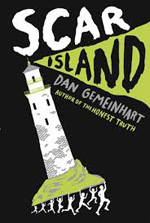 Twelve-year-old Jonathan Grisby has been sent to Slabhenge Reformatory School for Troubled Boys, a remote island fortress-like facility that was once an asylum for the criminally insane. Under the direction of the sadistic Admiral, the fifteen boys (ages 10 to 14) at the reform institution are subjected to hard work; horrible living conditions in dark, dank cells; starvation diets; and the constant threat of torturous punishment on a horrible device called the Sinner’s Sorrow. On the day after Jonathan’s arrival, the Admiral and all his staff are killed by lightning in a freak accident. Jonathan, who willingly accepted his ten-month sentence as just punishment, dreads the thought of returning home and proposes that the boys remain on the island for a few days to enjoy freedom from adult supervision. However, one of the older boys, as dictatorial as the Admiral, declares himself leader, and as a severe storm brews that may sink the island, Jonathan must come to terms with events in his past and assume leadership if he and the other boys are to survive. The short, action-packed chapters of this suspenseful and unusual adventure/survival story make it a good choice for a chapter-a-day read-aloud.
Twelve-year-old Jonathan Grisby has been sent to Slabhenge Reformatory School for Troubled Boys, a remote island fortress-like facility that was once an asylum for the criminally insane. Under the direction of the sadistic Admiral, the fifteen boys (ages 10 to 14) at the reform institution are subjected to hard work; horrible living conditions in dark, dank cells; starvation diets; and the constant threat of torturous punishment on a horrible device called the Sinner’s Sorrow. On the day after Jonathan’s arrival, the Admiral and all his staff are killed by lightning in a freak accident. Jonathan, who willingly accepted his ten-month sentence as just punishment, dreads the thought of returning home and proposes that the boys remain on the island for a few days to enjoy freedom from adult supervision. However, one of the older boys, as dictatorial as the Admiral, declares himself leader, and as a severe storm brews that may sink the island, Jonathan must come to terms with events in his past and assume leadership if he and the other boys are to survive. The short, action-packed chapters of this suspenseful and unusual adventure/survival story make it a good choice for a chapter-a-day read-aloud.
The Witch’s Vacuum Cleaner and Other Stories. Terry Pratchett. 2017. Katherine Tegen/HarperCollins.
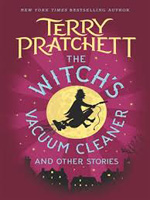 In an introduction written in 2015 (the year in which he died), Terry Pratchett tells of the origin of the collection’s 14 short stories, written when he was 17 and originally published in a local newspaper when he was a junior reporter. Pratchett states, “I tinkered here and there with a few details, added a few lines or notes, just because I can—and because as I’ve got older my imagination has got even bigger so I can’t stop myself from adding bits and bobs.” Pratchett’s stories take readers to strange and quirky places, where colorful people and creatures have wildly imaginative adventures. Pratchett fans will enjoy these tales as the beginning of his popular body of work; for others, they are the perfect introduction to a master writer of imaginative and humorous fantasy.
In an introduction written in 2015 (the year in which he died), Terry Pratchett tells of the origin of the collection’s 14 short stories, written when he was 17 and originally published in a local newspaper when he was a junior reporter. Pratchett states, “I tinkered here and there with a few details, added a few lines or notes, just because I can—and because as I’ve got older my imagination has got even bigger so I can’t stop myself from adding bits and bobs.” Pratchett’s stories take readers to strange and quirky places, where colorful people and creatures have wildly imaginative adventures. Pratchett fans will enjoy these tales as the beginning of his popular body of work; for others, they are the perfect introduction to a master writer of imaginative and humorous fantasy.
Ages 15+
The Legendary Miss Lena Horne. Carole Boston Weatherford. Ill. Elizabeth Zunon. 2017. Atheneum/Simon & Schuster.
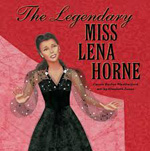 This picture-book celebration of Lena Horne, one of the most popular entertainers of the 20th century, begins with a quote from Horne herself, “You have to be taught to be second class; you’re not born that way.” Weatherford clearly shows how this belief was important throughout Horne’s life as a singer, actress, and civil rights activist in which she was, literally, a voice for African Americans. Zunon’s expressive oil paint and cut-paper collage illustrations put Horne in the spotlight whether she is performing as a vocalist for an all-white big band, singing at President Truman’s inaugural ball despite being blacklisted from movies and television, or singing the spiritual “This Little Light of Mine” at a 1963 rally with civil rights leader Medgar Evans. Back matter includes an author’s note, bibliography, and a “Further Reading, Listening, and Viewing” list. Also included is The Essential Lena Horne: The RCA Years (2010), an excellent CD for sharing some of Horne’s songs with students as a follow-up to the read-aloud.
This picture-book celebration of Lena Horne, one of the most popular entertainers of the 20th century, begins with a quote from Horne herself, “You have to be taught to be second class; you’re not born that way.” Weatherford clearly shows how this belief was important throughout Horne’s life as a singer, actress, and civil rights activist in which she was, literally, a voice for African Americans. Zunon’s expressive oil paint and cut-paper collage illustrations put Horne in the spotlight whether she is performing as a vocalist for an all-white big band, singing at President Truman’s inaugural ball despite being blacklisted from movies and television, or singing the spiritual “This Little Light of Mine” at a 1963 rally with civil rights leader Medgar Evans. Back matter includes an author’s note, bibliography, and a “Further Reading, Listening, and Viewing” list. Also included is The Essential Lena Horne: The RCA Years (2010), an excellent CD for sharing some of Horne’s songs with students as a follow-up to the read-aloud.
Carolyn Angus is former Director of the George G. Stone Center for Children's Books, Claremont Graduate University, in Claremont, California.
These reviews are submitted by members of the International Literacy Association's Children's Literature and Reading Special Interest Group (CL/R SIG) and are published weekly on Literacy Daily.